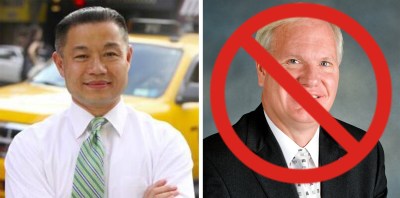Avella Lines Up for Rockaway Beach Rail Reactivation, Against QueensWay
As work is set to begin on a state-funded feasibility study to convert the Rockaway Beach Branch into a 3.5-mile park and multi-use path, State Senator Tony Avella — former City Council member, onetime mayoral hopeful, and current candidate for Queens borough president — is the latest elected official to line up behind southern Queens transit activists who are trying to stop the greenway plan and instead bring back rail service.

The Rockaway Beach Branch has remained unused for over four decades, with weeds growing over tracks that once took trains between the Long Island Rail Road main line in Rego Park and the Rockaways. Studies for the JFK AirTrain rejected the corridor as a route for the airport connector, and without rail service on the horizon, Friends of the QueensWay formed to push the park effort, winning the support of the Trust for Public Land and a $467,000 grant from the Cuomo administration last December to fund a feasibility study. The effort has gained the backing of a number of elected officials, with mayoral candidate Anthony Weiner unveiling his support in a policy book update this morning.
As the QueensWay has gained traction, others have ramped up the push to reactivate rail service instead.
Advocates from the Rockaways and central Queens neighborhoods formed the Queens Public Transit Committee early this year, taking an “all-of-the-above” approach by calling for Select Bus Service on Woodhaven Boulevard, improved local bus service in the Rockaways, and a permanent ferry from the Rockaways. They’ve also taken the unfortunate position of calling for tolls to be eliminated on the Cross Bay Bridge.
But Rockaway Beach Branch rail service is the group’s priority. “The most efficient way is this train system,” said committee leader Philip McManus of Rockaway Park. “This goes all the way from South Queens all the way into Manhattan, and the Select Bus Service will not do that.” McManus said a study should determine whether LIRR service, which would not require tunneling, or subway service, which would require a new tunnel beneath Rego Park connecting to Queens Boulevard, is the preferred option. “Whatever works,” he said at this morning’s press conference on Liberty Avenue. “We need a legitimate study, but it has to be first that the public needs to support this. That’s why we’re here.”
U.S. Representatives Hakeem Jeffries and Greg Meeks support federal funding for a feasibility study, and Avella joins Assembly members Phil Goldfelder and Mike Miller in advocating for rail.
If a feasibility study is conducted and political support lines up behind reactivation, the project would still need to secure funding from the MTA capital program. Avella, who opposed congestion pricing as a council member and mayoral candidate, thinks casinos could be a source of revenue for the project. “Hopefully the public will approve the gambling referendum that’ll be up in November,” he said. “That’s gonna generate billions of dollars.”
“It’s a transportation line,” McManus said, adding that it would be difficult for rail and trail to share it. “We don’t want a park, okay? We want a transportation option.”
Advocates for the QueensWay say it’s a transportation project that actually stands a chance of getting built. “I honestly see the QueensWay as improving the transportation mix. This isn’t just a park,” said Peter W. Beadle, who sits on the Friends of the QueensWay steering committee, noting that the bike network in central Queens is virtually non-existent and could be well-served by an elevated path. “It’s a choice between that or another 50 years of abandoned public infrastructure.”
Beadle also said that rail reactivation would mostly benefit Midtown-bound commuters from the Rockaways, using LIRR and subway trunk lines that are already nearing capacity. Center-running Woodhaven SBS would bring better transit to central Queens residents more quickly, Beadle said, and should be the focus of transit advocacy in the area.
Citing street-level parcels of the Rockaway Beach Branch that have been turned into parking lots, Beadle argued that creating a bike and pedestrian route would help preserve the right-of-way if transit becomes feasible in the future. “If you put a park there, you’re not going to keep handing out leases to companies for parking lots,” he said. Rail proponents point out that a completed QueensWay would create a constituency opposed to any future reactivation of the Rockaway Beach Branch.
As rail reactivation gains some political support, the QueensWay project is moving to the planning phase. In the next few weeks, the Trust for Public Land expects to announce the selection of a company to conduct a feasibility study for the project. The process is expected to take approximately one year to complete.
